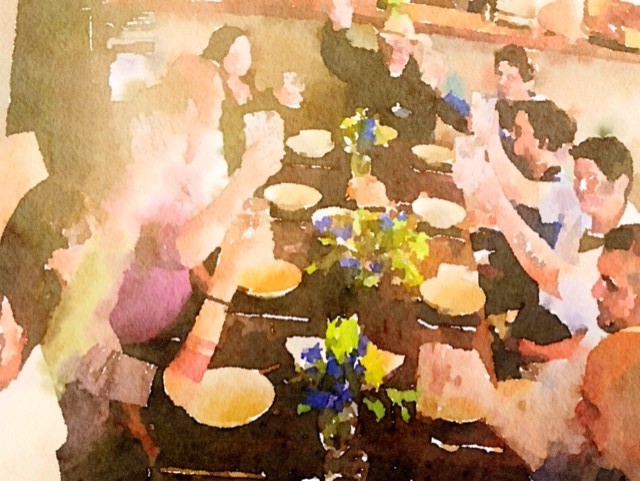
The most important room in a home is the kitchen. This is the hub of activity, the space that portrays unity, defines tradition, nourishes the body and mind, and sets the tone for communication. This is where we celebrate and reflect – the place where a cook offers the most important expression of love through the creative preparation of food. If the family were defined as a team, it would be the kitchen that served as the locker room and the playing field. The kitchen provides a platform for many of the most vivid memories of our lives and as such is cherished by all. Preparing for school or work, welcoming friends, and relatives, solving challenges, celebrating the end of the day, and listening to those reflections on life that everyone needs to share – this is the role of the kitchen and the family table.
Restaurants are very much like families, sometimes dysfunctional, but still family. Those who spend their days in the kitchen, or the dining room do so sometimes out of necessity, but oftentimes because it is what they love to do – to create and bring a little joy to other’s lives. We work hard, very hard physically, mentally, and even emotionally through the process of preparing and serving delicious food. The kitchen is where we put our acquired skills to the test from simple knife work to mastering the foundational cooking methods and building sophisticated palates. Some may be just starting out while others are seasoned veterans. We wear our battle scars with pride: the burns, cuts, occasional stitches, swollen feet, and carpel tunnel hands – these are the symbols of our work ethic and the dangers that do exist in the kitchen. These unplanned tattoos are a rite of passage, our report cards that help to define when we have passed the test of time in front of the range.
The dining room staff face some different marks in time that establish them as “prepared”. There are the emotional scars from that small percentage of guests who fail to treat the staff with any level of respect, the demands of timing, the challenges in upselling, and the struggle to always keep a smile on their face. They are the ambassadors of hospitality and need to maintain a semblance of calm and the stage presence that helps guests feel comfortable and at ease.
In both cases, there is a high level of stress in restaurant work. Fast, efficient, poised, and graceful, flexible, able to recover from mistakes, organized, a problem solver, and skilled, all come into play every day, with every guest. Managing all of this will fail if there isn’t a place to gather, decompress, share, and consult. Just like the family table at home – the staff meal can be the place where front and back of the house staff members come together, build understanding, support each other, laugh, and even cry as they prepare for another day of craziness. Breaking bread together becomes that universal language, that calming process, the chance to celebrate each other, raise a glass and welcome the work that is done in service of the food that represents tradition and art, and the hospitality that can make a guest’s day.
“Some of the most important conversations I’ve ever had occurred at the family dinner table.”
-Bob Ehrlich
(Former Governor of Maryland)

How important is the staff meal to the success of a restaurant? I would propose that during these times of real uncertainty, a time when restaurants are seeking answers to the challenges that plague them, such as the difficulty in finding and retaining staff – the family meal, in the truest sense of the term is of consummate importance. Now, there is a difference between putting out a few bowls of salad, a sheet of pizza, or ten pounds of pasta and creating a family meal. So, let’s be clear about what it takes to build this cohesive team (family) through food.
- DEDICATE THE TIME
If this is to work, then the 10-minute family meal won’t cut it. Build 30 minutes into your planning and schedule before you open the dining room.
- DEDICATE THE SPACE
Make it a long table so that everyone can sit together as a family. Set the table correctly – put out the good china and flatware, baskets of bread, family style bowls and platters to pass around.
- COOK LIKE IT WAS FAMILY
No need for expensive ingredients, just well-prepared food, ample portions, full flavor, good technique. Invest the time to make it as you would for a guest or family member. Dedicate one your cooks each night to be the guest chef. Plan the menus for a week and post them – build anticipation for the family meal.
- MIX AND MATCH
Break up the us and them. Mix front and back of the house to create an environment for friendly discussion and a chance to get to know each other on a different level.
- EVERYONE PARTICIPATES
No one is AWOL from family meal including chef, sous chef, manager, dishwasher, and cooks who are behind on their mise en place.
- FOOD and WINE CENTERPIECE OF CONVERSATION
The guest chef for family meal should talk about the food, its history, connection to his or her family, etc.
- MAKE IT EDUCATIONAL
This is a perfect time for your sommelier to introduce a new wine on your list. A sample for everyone, discussions about pairing, the grape, terroir, flavor profile, etc.
- FEATURE TRADITIONS and HISTORY
Encourage your guest chefs to bring their heritage into the meal. You may want to include your dishwashers as guest chefs as well. You will be amazed at the food that comes to the plate.
- CELEBRATE YOUR STAFF
The family meal is also a time to give thanks for staff members – celebrate something – length of service, highest check average, new dish created for the menu, completion of a degree, birth of a baby, etc. There is always something worth celebrating in a family.
Push aside all of the negative reasons why this won’t work: too expensive, can’t find the time – we are too busy, just more work for the cooks, they won’t appreciate it so why bother, too much trouble, etc. Give it a try! Even if you only do this once a week to start – make it a critical part of how you do business and watch how the team starts to become a family. The payback can be team unity, better understanding, pride, a feeling that the restaurant cares about employees, more open dialogue, stronger connections with management, and less friction between front and back of the house. A small step, but a giant leap for any restaurant.
“You learn a lot about someone when you share a meal together.”
-Anthony Bourdain
PLAN BETTER – TRAIN HARDER
Harvest America Ventures, LLC
www.harvestamericacues.com BLOG
CAFÉ Talks Podcast

Leave a comment